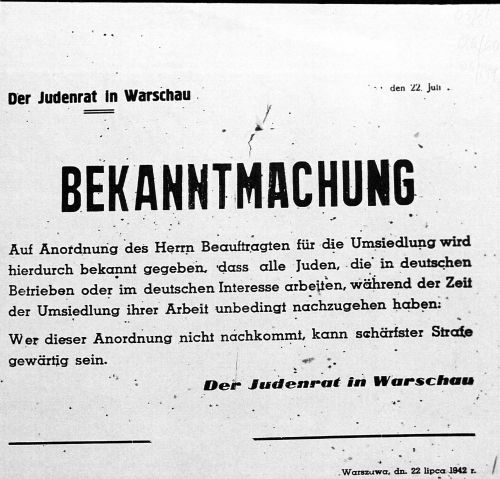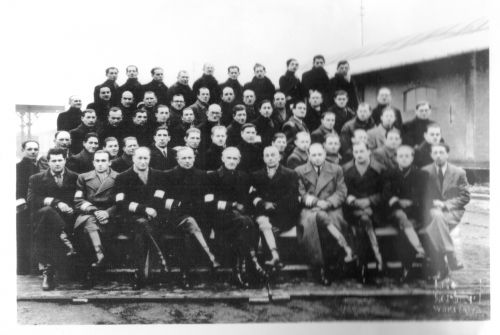Warsaw ghetto - Grosaktion Summer 1942

On July 15, 1942, the German team arrived in Warsaw that had carried out the deportations in the Lublin District that spring, at the start of the enormous Aktion that was later known as Aktion or Einsatz Reinhardt, named after the moving spirit behind the destruction of European Jewry, Reinhard Heydrich.
Experienced SS-men now arrived to direct the extermination aktion in Warsaw and in other locations within the Generalgouvernement. The commander -in-chief was SS-Sturmbannfuhrer Herman Julius Hofle, whose headquarters in Warsaw was at 103 Zelazna Street, in the building that became known as the Befehlstelle. The team included a dozen or so German SS-men and Gestapo, Latvians, Ukrainians and Lithuanians. The second centre in the ghetto for Aktion Reinhardt was in the headquarters of the Jewish Order Service, at 17 Ogrodowa Street , where SS men based in Warsaw and Gestapo members were posted. These included men who had contact earlier with the ghetto as part of their duties in the SS or SD.
Two employees of the section IV-B of the Security Police and Security Service were very active in the period of the occupation and the deportations from Warsaw, were SS-Untersturmfuhrer Karl Brandt, and SS-Oberscharfuhrer Gerhard Mende. These two men decided on the course and tempo of the Aktion. Karl Brandt was indefatigable, and seemed to be omnipresent. He is remembered for the fact that during selections he never even bothered to even glance at the person's documents, but decided their fate by his visual impression of them and his mood at the time. He was reputed to be mercurial, and his fits of rage wrought destruction on countless numbers of people.
Gerhard Mende, on the other hand, was a quiet man, self-possessed, and highly diligent in his work. He was among the officers who freely graced documents with the SS-SD stamp, which gave their bearers a false sense of security, yet a few days later he would lead his men in an Aktion and totally ignore those very same documents. The division of duties and competence between the two deportation centres - the one in Warsaw and the one in Lublin is unclear.
On July 22, 1942, the deportation of the Jewish inhabitants of the Warsaw Ghetto, to Treblinka, with its murderous gas chambers began. The deportation had its own dynamics. Initially, the Germans declared that they did not intend to deport all the Jews, leaving open various escape routes and possibilities of evasion. This meant that everyone began to try to get into the category of people who would remain in the ghetto. At first for ten days employment certificates were honoured, but they later gradually lost their value. They set the Warsaw people against the refugees, allegedly freeing the community of unproductive elements.
The Jewish Order Service were promised personal safety and the safety of family members, even uncles, in-laws, and distant relatives. Later safety was promised to those employed in the shops, as opposed to other forms of employment, and then they set one 'shop' against another. Then women and children in the 'shops' themselves. Later they separated less healthy workers from those who were stronger. Better and worse 'shops,' red stamps, constantly tightening the noose.
The Jewish Order Service played an important and truly a disgraceful role in the deportations. This was undoubtedly the case in the first phase of the deportations. The Jewish policemen - Sluzba Porzadkowa (SP) directly carried out German orders. The modus operandi of the Aktion was to blockade a particular house or several houses or streets. The Germans decided in what order inhabitants of the ghetto would be deported. 'At dawn an officer of the Jewish police opened a sealed envelope, in which there was a sheet of paper detailing the streets and housing blocks which were to be shaken out on a given day.' The blockade of a house began with detailing there a team of ghetto police, fifteen to twenty-five men under the command of an SP officer. The gate and all ways out were closed. The residents were driven into the courtyard, where their documents were checked. Those who had 'good' documents could stay, while the rest were taken under escort, in horse-drawn carts, or on foot, to the Umschlagplatz.
The Germans or Jewish policemen went through the flats, checking whether anyone remained. Those found hiding were usually killed on the spot or sent to the Umschlagplatz. During the initial stages of the Aktion, the Jewish policemen were notorious for their cruelty and corruption. During the deportations three groups of Jews were untouchable: policemen, grave diggers and carters. The Germans took care of the horses that pulled the carts, that transported people to the Umschlagplatz. They were given full military rations - oats, straw and hay - directly from the stores of the Truppenwirtschaftslager der Waffen in Zoliborz.
In the Umschlagplatz people were loaded onto trains. Some of the young men were sent to the Durchgangslager, from which they were taken to labour camps. Some of the elderly, the sick, or the infirm were shot on the spot, or were shot in the Jewish cemetery. As a result of various appeals by managers of the Jewish 'shops,' Jewish policemen who had been bribed or were friends of those caught, and doctors from the hospital, a small number of those caught were released; the majority however, were taken to the Treblinka death camp.
It was often necessary to wait for the trains , so the Jews sat on the ground or in the buildings at the Umschlagplatz. Sometimes they waited all night. The Germans appointed as commander of the Umschlagplatz Mieczyslaw Szmerling, a deputy district commander of the Jewish Order Service. After a few days he was promoted to District Commander on Karl Brandt's orders, as well as chairman of the Anti-Epidemic Section. Jozef Rode- Rucz, an SP district officer, who at one time was in charge of the Central Prison for Jews in Warsaw, a former NCO in the Foreign Legion.

Warsaw Umschlagplatz - Jewish Order Service Unit (Holocaust Historical Society)

